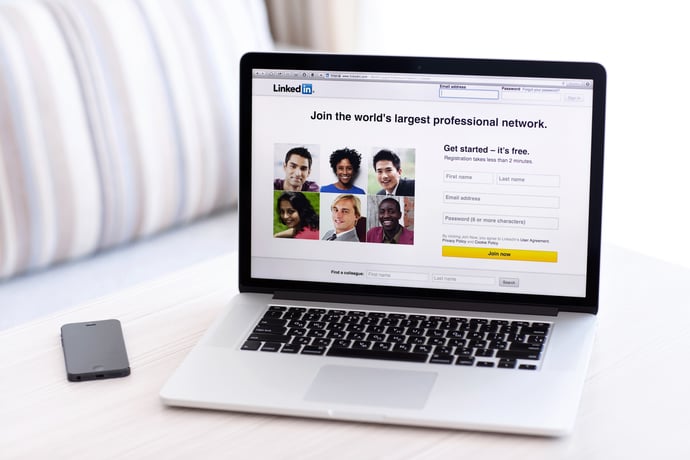February 9, 2023
 by Kristina Nauman / February 9, 2023
by Kristina Nauman / February 9, 2023

At the end of the day, business is about people.
From the ones who hire you to the ones who buy from you, people are what keep industries going. Working on professional relationships can bring the highest form of returns, more than any other investment. So, if building a network is not at the top of your list, it should be.
As a business in the modern digital world, building a community is a must for maintaining an online presence. Customer-to-customer (C2C) community marketing software can help you build online communities, hold networking events to promote your brand and increase customer engagement.
Networking is so powerful that there is an entire social media platform, LinkedIn, dedicated to connecting professionals and business leaders across the globe.
LinkedIn is perfect for seeking all kinds of networking opportunities. You can connect and learn from industry experts, build business partnerships, talk to potential employers, hire people for your company, and everything in between.
As of December 2022, LinkedIn has over 875 million members from 58 million registered companies worldwide, making it the world’s largest online professional network. With such a valuable ecosystem at your fingertips, it’s essential to know how to network on LinkedIn to get the most out of your presence on the platform.
Whether you’re a new user, kicking off a job search, or learning to be more active on the platform, keep in mind the following dos and don’ts of networking on LinkedIn.
To leverage LinkedIn's networking capabilities, you need to set up your profile so people can find and connect with you. Ensuring all areas of your profile are complete will make you more searchable and impress visitors when they land on your page.
Having a professional headshot for your LinkedIn profile will get you more views compared to leaving that space blank. Plus, you don’t need an experienced photographer to get a good picture. Just get it clicked with a good smartphone camera, tweak it with photo editing software, and you’re good to go.
Similarly, putting on a suitable banner can bring out the perfect look of your profile. Many companies use their own template images for banners, which can enhance your overall profile experience.
Tip: Crop your LinkedIn profile photo to the ideal aspect ratio, i.e., 400 x 400 pixels
The headline section allows you to add a quick blurb about what you do. This space is essential because it is the first thing users will see under your name on your profile, and it also displays on your posts in the LinkedIn feed – right next to your profile photo.
A common practice for headline writing is to write your job title and company, but some people opt for more creative phrases. Suppose you are a student seeking your first opportunity. In that case, you should include keywords matching your desired role's expected skill set. It will cue recruiters that you are an ideal match and are open to work.
Next, refine your LinkedIn Summary. With 2,000 characters available, this is likely the most comprehensive bio you can write on social media. If done correctly, you can grab the decision-maker’s attention and convince industry counterparts to connect with you.
The summary is perfect for giving your audience an accurate picture of your work and how it differentiates from other professionals. Incorporate key terms and phrases that hiring managers and colleagues are likely to search for, and don't be afraid to add a little personality to it as well.
However, one thing to be cognizant of with your LinkedIn Summary is that you need to do more than just reiterate the information in your experience section. Being creative is the key.
LinkedIn carries a slew of features that aim to drive engagement on the platform. One of these features is the ability to follow hashtags. Users can see curated posts from brands and professionals that contain the tags they follow. It's a great way to start finding and connecting with people sharing relevant content in your industry.
You can also use hashtags in your LinkedIn posts to boost reachability. Adding these tags can help surface your content to members who may find it interesting. By sharing relevant, thoughtful content and hashtagging it appropriately, you can begin to build your thought leadership on LinkedIn.
Just make sure to stay moderate with hashtags; three to five per post is enough. Add a couple of line breaks from your copy to keep it clean and readable.
of the social traffic reaching business-to-business (B2B) websites is driven by LinkedIn.
Source: Kinsta
As a general rule of thumb, connect with current and former colleagues on LinkedIn first. You can do this by uploading a list of professional contacts, searching for people by name, or looking up employees of specific organizations by clicking 'See all employees on LinkedIn' on their page. Connecting to these people is a good start in setting the foundation of your professional network on the platform.
Once you're ready to expand this network, LinkedIn groups are a great place to start. LinkedIn groups are one of the platform's most robust networking tools. They allow professionals to share insights and experiences, ask for professional guidance, and build valuable connections.
Try using the search feature to find groups relevant to your interests. It could be anything from industry-related topics to alum networks. Search for common keywords that other professionals in your field use to pull in the most relevant results.
Groups provide a variety of ways to start and contribute to conversations. As a member, you can post articles, upload documents, share a video, post text updates, and comment on other members' posts.
As you explore this territory, you must keep in mind a few best practices to ensure you're contributing to your groups in the most valuable way. LinkedIn shares the following tips:
The best way to create a meaningful connection is by personalizing your conversation. Be it a connection request or your campaign to sell services, don’t make it generic. Avoid sending automated messages to every connection. Adding personality and humor is a great way to stand out in their inbox.
Defining your target persona is a great way to personalize the outreach effort. A little audience research can go a long way in boosting your response rate. Be specific about why you’re reaching out, and consider addressing some pain points your research tells you about.
Also, taking a follow-up is as important as reaching out in the first place. It shows you genuinely care about the cause and increases your chances of being noticed in the swamp of other connections. But make sure your follow-ups are casual and not spamming them.
Comments are an excellent opportunity to network with new connections or even with professionals outside your current circle. Many people make the common mistake of ignoring comments under their LinkedIn posts or not engaging with other people's posts.
Use commenting platforms to enhance your audience engagement and moderate comments. Try engaging with other posts by asking a follow-up question, sharing your experience, adding insights to the discussion, or simply thanking them for sharing a great post.
By leaving a meaningful comment unique to your perspective and adding value, you can stand out from others in the busiest comment sections. Whether you are a newbie or a veteran on the platform, this is a good networking practice to build on.
The quickest way to feel discouraged when starting to network on LinkedIn is by expecting too much out of the process. Not everyone you reach out to is bound to respond, return engagement, or even accept your invite. And that’s perfectly fine!
You might feel you have tried all of the above tips, and it’s not working for you. But the truth is, sometimes there will be factors that are beyond your control. It doesn’t mean there is something wrong with your approach.
Some people might be less active on the platform, while others might seek something different from their potential connections. So, avoid taking things personally. Consistency is key when it comes to engaging with an audience.
Building connections starts with a click. Show what you’re worth and lend a virtual hand to build on opportunities. By optimizing your profile, joining relevant groups, and taking advantage of interactive tools on the platform, you’ll be well on your way to building solid connections on LinkedIn.
If done correctly, growing a professional network will take time. Remember to stay patient throughout this process.
Ready to build and manage your online network better? Create a productive digital space using online community management software and take effective steps to increase audience engagement.
This article was originally published in 2019. It has been updated with new information.
Kristina's role at Ignite Social Media is that of a Strategist- she helps craft strategic plans that meet client objectives, researches best practices in the world of social media and provides ongoing strategy recommendations to our clients. She has experience working in industries such as retail, travel and hospitality and higher education.
Since Mark Zuckerberg first mentioned it, everyone has kept talking about the metaverse as a...
 by Yuri Milyutin
by Yuri Milyutin
This guide is for anyone who’s trying to build a new local service or grow their company.
 by Parikshit Joshi
by Parikshit Joshi
As a content marketer, I am sure you would have never had it easy.
 by Victoria Taylor
by Victoria Taylor
Since Mark Zuckerberg first mentioned it, everyone has kept talking about the metaverse as a...
 by Yuri Milyutin
by Yuri Milyutin
This guide is for anyone who’s trying to build a new local service or grow their company.
 by Parikshit Joshi
by Parikshit Joshi


